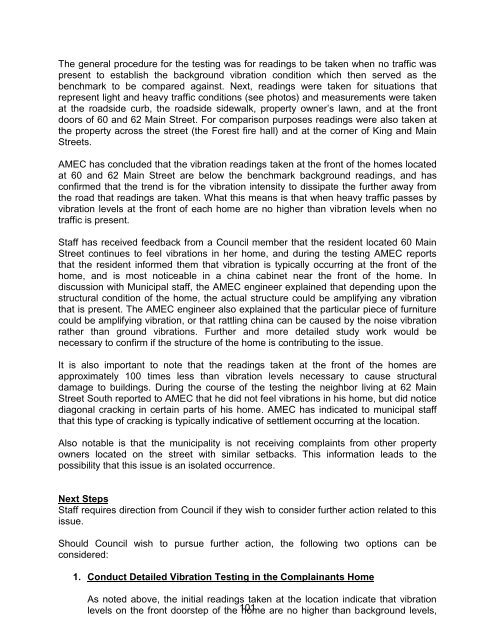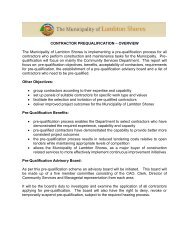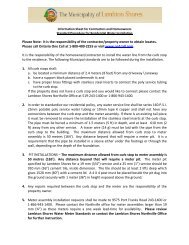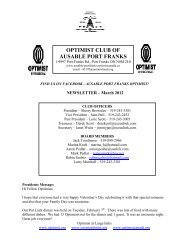View - The Municipality of Lambton Shores
View - The Municipality of Lambton Shores
View - The Municipality of Lambton Shores
Create successful ePaper yourself
Turn your PDF publications into a flip-book with our unique Google optimized e-Paper software.
<strong>The</strong> general procedure for the testing was for readings to be taken when no traffic was<br />
present to establish the background vibration condition which then served as the<br />
benchmark to be compared against. Next, readings were taken for situations that<br />
represent light and heavy traffic conditions (see photos) and measurements were taken<br />
at the roadside curb, the roadside sidewalk, property owner’s lawn, and at the front<br />
doors <strong>of</strong> 60 and 62 Main Street. For comparison purposes readings were also taken at<br />
the property across the street (the Forest fire hall) and at the corner <strong>of</strong> King and Main<br />
Streets.<br />
AMEC has concluded that the vibration readings taken at the front <strong>of</strong> the homes located<br />
at 60 and 62 Main Street are below the benchmark background readings, and has<br />
confirmed that the trend is for the vibration intensity to dissipate the further away from<br />
the road that readings are taken. What this means is that when heavy traffic passes by<br />
vibration levels at the front <strong>of</strong> each home are no higher than vibration levels when no<br />
traffic is present.<br />
Staff has received feedback from a Council member that the resident located 60 Main<br />
Street continues to feel vibrations in her home, and during the testing AMEC reports<br />
that the resident informed them that vibration is typically occurring at the front <strong>of</strong> the<br />
home, and is most noticeable in a china cabinet near the front <strong>of</strong> the home. In<br />
discussion with Municipal staff, the AMEC engineer explained that depending upon the<br />
structural condition <strong>of</strong> the home, the actual structure could be amplifying any vibration<br />
that is present. <strong>The</strong> AMEC engineer also explained that the particular piece <strong>of</strong> furniture<br />
could be amplifying vibration, or that rattling china can be caused by the noise vibration<br />
rather than ground vibrations. Further and more detailed study work would be<br />
necessary to confirm if the structure <strong>of</strong> the home is contributing to the issue.<br />
It is also important to note that the readings taken at the front <strong>of</strong> the homes are<br />
approximately 100 times less than vibration levels necessary to cause structural<br />
damage to buildings. During the course <strong>of</strong> the testing the neighbor living at 62 Main<br />
Street South reported to AMEC that he did not feel vibrations in his home, but did notice<br />
diagonal cracking in certain parts <strong>of</strong> his home. AMEC has indicated to municipal staff<br />
that this type <strong>of</strong> cracking is typically indicative <strong>of</strong> settlement occurring at the location.<br />
Also notable is that the municipality is not receiving complaints from other property<br />
owners located on the street with similar setbacks. This information leads to the<br />
possibility that this issue is an isolated occurrence.<br />
Next Steps<br />
Staff requires direction from Council if they wish to consider further action related to this<br />
issue.<br />
Should Council wish to pursue further action, the following two options can be<br />
considered:<br />
1. Conduct Detailed Vibration Testing in the Complainants Home<br />
As noted above, the initial readings taken at the location indicate that vibration<br />
levels on the front doorstep <strong>of</strong> the 101 home are no higher than background levels,

















